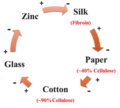Triboelectric effect
Phenomenon where certain materials become electrically charged after coming into contact with a different material
The triboelectric effect is a type of contact electrification in which certain materials become electrically charged after they are separated from a different material with which they were in contact. This phenomenon is commonly experienced in everyday life, such as when a person walks across a carpet and then touches a metal doorknob, resulting in a static shock.
Mechanism
The triboelectric effect occurs when two materials are brought into contact and then separated. During contact, electrons may transfer from one material to the other, depending on their relative positions in the triboelectric series. The material that loses electrons becomes positively charged, while the material that gains electrons becomes negatively charged.
The amount of charge transferred depends on several factors, including the nature of the materials, the surface roughness, and the environmental conditions such as humidity. The presence of asperities or microscopic surface roughness can enhance the effect by increasing the contact area.
Triboelectric Series
The triboelectric series is a list that ranks materials according to their tendency to gain or lose electrons. Materials at the top of the series, such as glass, tend to lose electrons and become positively charged, while materials at the bottom, such as rubber, tend to gain electrons and become negatively charged.
Applications
The triboelectric effect has several practical applications. It is used in triboelectric nanogenerators (TENGs) to convert mechanical energy into electrical energy. These devices can harvest energy from various sources, such as human motion or environmental vibrations.
The effect is also utilized in electrostatic precipitators to remove particles from exhaust gases in industrial processes. Additionally, it plays a role in the operation of xerography, a dry photocopying technique.
Hazards
The triboelectric effect can pose hazards in certain situations. For example, static electricity generated by the effect can ignite flammable gases or dust, leading to explosions. In the electronics industry, static discharge can damage sensitive components, necessitating the use of antistatic measures.
Related pages
References
- Jones, T. B. (2001). Electromechanics of Particles. Cambridge University Press.
- Harper, W. R. (1967). Contact and Frictional Electrification. Oxford University Press.
Gallery
Transform your life with W8MD's budget GLP-1 injections from $125.
W8MD offers a medical weight loss program to lose weight in Philadelphia. Our physician-supervised medical weight loss provides:
- Most insurances accepted or discounted self-pay rates. We will obtain insurance prior authorizations if needed.
- Generic GLP1 weight loss injections from $125 for the starting dose.
- Also offer prescription weight loss medications including Phentermine, Qsymia, Diethylpropion, Contrave etc.
NYC weight loss doctor appointments
Start your NYC weight loss journey today at our NYC medical weight loss and Philadelphia medical weight loss clinics.
- Call 718-946-5500 to lose weight in NYC or for medical weight loss in Philadelphia 215-676-2334.
- Tags:NYC medical weight loss, Philadelphia lose weight Zepbound NYC, Budget GLP1 weight loss injections, Wegovy Philadelphia, Wegovy NYC, Philadelphia medical weight loss, Brookly weight loss and Wegovy NYC
|
WikiMD's Wellness Encyclopedia |
| Let Food Be Thy Medicine Medicine Thy Food - Hippocrates |
Medical Disclaimer: WikiMD is not a substitute for professional medical advice. The information on WikiMD is provided as an information resource only, may be incorrect, outdated or misleading, and is not to be used or relied on for any diagnostic or treatment purposes. Please consult your health care provider before making any healthcare decisions or for guidance about a specific medical condition. WikiMD expressly disclaims responsibility, and shall have no liability, for any damages, loss, injury, or liability whatsoever suffered as a result of your reliance on the information contained in this site. By visiting this site you agree to the foregoing terms and conditions, which may from time to time be changed or supplemented by WikiMD. If you do not agree to the foregoing terms and conditions, you should not enter or use this site. See full disclaimer.
Credits:Most images are courtesy of Wikimedia commons, and templates, categories Wikipedia, licensed under CC BY SA or similar.
Contributors: Prab R. Tumpati, MD











